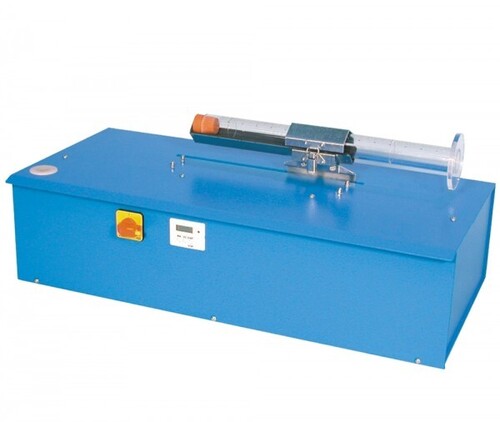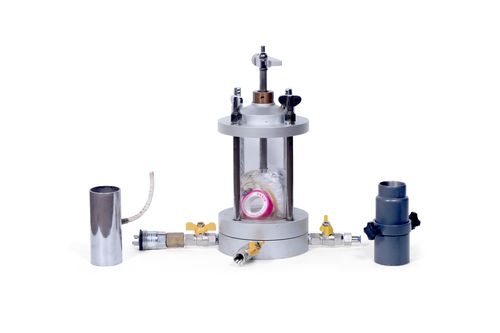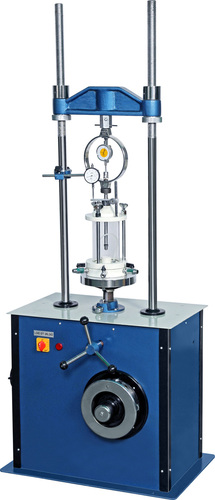SAND EQUIVALENT MECHANICAL SHAKER - Motorized
Price 1.00 INR/ Piece
SAND EQUIVALENT MECHANICAL SHAKER - Motorized Specification
- Features
- Sturdy steel construction, Removable sample holder, Non-slip feet, Overload protection
- Interface Type
- Manual controls
- Humidity
- Up to 90% RH, non-condensing
- Mounting Type
- Tabletop
- Display Type
- Analog Timer
- Frequency
- 50 Hz
- Port Size
- Standard sample tube holder
- Application
- Determination of Sand Equivalent Value in Soil and Aggregates
- Dimension (L*W*H)
- 25 X 19 X 20 (L x W x H) Millimeter (mm)
- Response Time
- Immediate on startup
- Product Type
- Sand Equivalent Mechanical Shaker
- Max Height
- Approx. 20 inch
- Operating Voltage
- 230V AC
- Power Supply
- 230V AC, 50Hz, Single Phase
- Number of Specimens
- One at a time
- Measuring Range
- Up to 100 SE value
- Equipment Type
- Mechanical Shaker
- Temperature
- Operating: 5C to 40C
- Usage
- Soil Testing Equipment
- Specimen Size
- Standard sample tube
- Resolution
- 0.1 stroke
- Accuracy
- 1.5 strokes/min
- Automation Grade
- Semi-Automatic
- Test Range
- Sand Equivalent from 0 to 100
- Capacity
- Single sample per operation
- Machine Weight
- Approx. 40 kg
- Test Speed
- 175 2 strokes/min
- Test Width
- Standard lab bench size
- Test Stroke
- 203 mm (8 inch)
- Control Mode
- Motorized
SAND EQUIVALENT MECHANICAL SHAKER - Motorized Trade Information
- Minimum Order Quantity
- 1 Piece
- Supply Ability
- 100 Pieces Per Month
- Delivery Time
- 4 Week
- Sample Policy
- Contact us for information regarding our sample policy
- Packaging Details
- Wooden Box / Corrugated Box
- Certifications
- ISO 9001 : 2015
About SAND EQUIVALENT MECHANICAL SHAKER - Motorized
Application:
EIE Sand Equivalent Mechanical Shaker is recommended for labs performing sand equivalent tests on a regular basis.
Description of Test:
- Supplied with accurate electronic timer preset at 45 seconds as per testrequirements.
- The instrument will be stopped automatically at the end of test time interval.
- Electric motor of the instrument will be of reputed make
- The gear and motor mechanism will be housed in a sturdy enclosure.
- Test cylinder is held securely by base pin and spring loaded holder on stopper end.
- Exterior body of the machine will be made from Mild Steel material, which is powder coated in attractive shades.
- Aesthetic outer appearance
- Simple and easy to operate design
- Operates on 230 Volts, 50 Hz, Single phase, AC Supply
Further details available on our website.
The Price mentioned here are subject to change as per the capacity,specifications and application of the user.
Reliable Performance in Soil and Aggregate Testing
This mechanical shaker is engineered for accurate and repeatable sand equivalent determination, crucial in quality control of soils and aggregates. The removable sample holder and simple manual controls facilitate straightforward operation and maintenance. Its sturdy construction and compact size allow it to sit securely on a standard laboratory bench, making it suitable for a wide range of professional and educational environments.
Ease of Use and Maintenance
Featuring a semi-automatic motorized drive and analog timer, the shaker requires minimal manual intervention, enhancing operational efficiency. The spring-loaded sample clamp and non-slip feet ensure both safety and convenience. Overload protection adds another layer of safety, keeping downtime to a minimum and prolonging the equipments lifespan.
FAQs of SAND EQUIVALENT MECHANICAL SHAKER - Motorized:
Q: How does the Sand Equivalent Mechanical Shaker operate?
A: The shaker utilizes an eccentric cam drive mechanism that delivers 175 2 strokes per minute to agitate the sample. The process is timed using an analog timer (up to 15 minutes), and the test is conducted with a spring-loaded clamp holding the standard sample tube in place.Q: What is the main application of this mechanical shaker?
A: It is primarily used to determine the sand equivalent value in soil and aggregate samples, following ASTM D2419 and AASHTO T176 standards. This measurement helps assess the relative proportion of fine dust versus sand in materials used for construction and roadworks.Q: When should I use this equipment during soil testing?
A: The mechanical shaker should be used during laboratory analysis whenever sand equivalent values are required for soils or aggregates, such as in quality control or compliance testing for infrastructure projects.Q: Where can this shaker be installed?
A: The machines compact design and table-top mounting make it suitable for standard laboratory benches in geotechnical, civil engineering, or educational laboratories.Q: What is the procedure for conducting a test with this machine?
A: Place your prepared sample into the standard tube and secure it using the spring-loaded clamp. Set the desired time on the analog timer, start the shaker, and allow it to operate. After completion, evaluate the sand equivalent value using the test result.Q: What benefits does this model offer over manual methods?
A: The motorized, semi-automatic operation ensures consistent agitation and precise timing, which minimizes user error, improves repeatability, and saves time compared to hand-shaking samples.Q: Is the shaker suitable for all working environments?
A: Yes, as long as the laboratory meets its operating conditionstemperature between 5C to 40C and humidity up to 90% RH, non-condensingthe shaker performs reliably and quietly, with noise levels below 70 dB.


Price:
- 50
- 100
- 200
- 250
- 500
- 1000+
More Products in Soil Testing Equipments Category
Triaxial Cell
Price 1.00 INR / Piece
Minimum Order Quantity : 1 Piece
Max Height : 450 mm
Measuring Range : 020 kN
Usage : Geotechnical laboratory
Resolution : 0.01 kN
Digital Triaxial Shear Test Apparatus
Price 1.00 INR / Piece
Minimum Order Quantity : 1 Piece
Max Height : 600 mm (machine dimensions)
Measuring Range : 0100 kN
Usage : Laboratory
Resolution : 0.001 kN
Triaxial Shear Test Apparatus
Price 1.00 INR / Piece
Minimum Order Quantity : 1 Piece
Max Height : Approximately 1000 mm
Measuring Range : 0100% (adjustable depending on transducer type)
Usage : Soil Testing Equipment
Resolution : 0.01 kN / 0.01 mm
Grain Size Analysis Apparatus Pipette Method
Price 1.00 INR / Piece
Minimum Order Quantity : 1 Piece
Max Height : 870 mm
Measuring Range : 0.002 mm to 2 mm grain size
Usage : Soil Testing Equipment
Resolution : 0.001 mm
 |
EIE INSTRUMENTS PVT. LTD.
All Rights Reserved.(Terms of Use) Developed and Managed by Infocom Network Private Limited. |

 Send Inquiry
Send Inquiry




